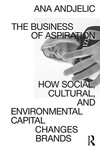The Business of Aspiration: How Social, Cultural, and Environmental Capital Changes Brands
amazon.com
Saved by Patrick Prothe and
The Business of Aspiration: How Social, Cultural, and Environmental Capital Changes Brands

Saved by Patrick Prothe and
A decade or so ago, brands shifted from increasing value of their products through utility, competitive comparison, and creative advertising to endowing products they made with aesthetic, sustainability credentials, a story of artisanship and provenance, and/or a community in order to give their products identity and singularity. (Virgil Abloh made
... See moreAny aspiration is a narrative: it’s the stories we buy into and the products and experiences we buy to be part of these stories.
The rich belong to the old industrial economy and to the traditional luxury. They own objects that signify stability, security, and durability (real estate, hard luxury, antiques, high-end wine, collectible art). The core promise of hard luxury is its permanence (“You never really own Patek Philippe. You merely look after it for the next generation
... See moreSocial. People are not only individuals but also belong to communities and are members of a society. Their behaviors are shaped by those around them and by collective symbols and stories. The new target unit for brands are a community and a society, not an individual. Modern brand strategy aims to address not just “jobs to be done,” but jobs to be
... See moreAlong with intangibles like access, experiences, and knowledge, the modern aspiration economy also created a cultural class unto its own. Oriented towards wellness and self-perfecting, this class of self-proclaimed “creatives” (regardless of what they actually do) defies the hierarchy that socially bound the previous generations to their economic s
... See moreShift from the outside to the inside If the latest trend in the modern travel is any indication, the affluent travel for learning, not leisure, and for transformation, and not thrill.
Recognize that, for your customers, a slower pace of life is a good thing Before the global pandemic, it was popular to discuss the damage of social media to our brains, psyches, and social lives. Artist Jenny Odell wrote a book titled How to Do Nothing, about resisting the attention economy. Doing nothing is what most of us don’t know how to do. T
... See moreBrands can capitalize on restraint as the new aspiration by putting forward social values of generosity, compassion, and gratitude, and acting on them through their content, communication, and brand behaviors.
Across categories, there has been a move toward smaller, more decentralized offerings revolving around personalization and hyper-focused inventory.